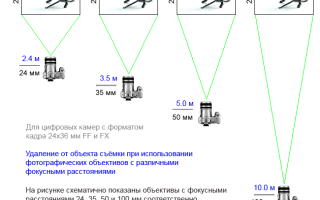Minimum shooting distance
Properties of FF and FX lenses
You can find many articles about the effect of lens focal length on the transfer of perspective in a photograph. Behind these descriptions, the main purpose of interchangeable photographic optics (interchangeable lenses for system cameras) was somehow forgotten. The material below is devoted to these properties of optics for FF and
As always, a little history. The first lenses were designed based on a simple premise, the essence of which was to convey perspective as the human eye sees it, or more precisely, as the brain perceives this perspective.
Of course, artists experimented in attempts to convey perspective somewhat differently than what human eyes see, but the matter was limited to experiments.
The first photographers were quite happy with this situation, because many of them were excellent draftsmen.
However, as photography developed and both the cameras themselves and photographic materials improved, new needs began to arise.
First of all, these needs were related to photographing distant objects that are difficult or impossible to approach. For example, a house located on the opposite bank of the river. Attempts to combine a camera and a telescope began to appear, figuratively speaking. This gave birth to long-focus lenses, the focal length of which exceeded the focal length of a standard lens.
On the other hand, there was shooting in cramped rooms or on cramped streets, as well as in other places where the photographer could not step back to the required distance so that the subject would fit completely into the frame. For such shooting, a lens with a coverage angle exceeding the coverage angle of a standard lens was needed.
It is believed that fisheye lenses were originally created for the purpose of studying ice conditions. To do this, the camera was mounted on an airplane, and the lens axis was directed vertically downward. This solution made it possible to obtain images of the ice field up to the horizon.
In other words, interchangeable lenses originally served to “bring closer” or “farther away” the subject of photography.
Distance from the subject when shooting with lenses of different focal lengths
There is a simple rule of thumb that relates three quantities: the size of the subject, the shooting distance, and the focal length of the lens.
Due to the great popularity of the “watering can” format, this rule was developed just for it. In the digital era, the “lens” format includes the FF and FX formats, in which the size of the photosensitive matrix is 24x36 mm.
Fig.1. Distance from the subject when shooting with 24, 35, 50 and 100 mm lenses
The rule is very simple: if the subject has constant dimensions (in our example, 2.4x3.6 m), then the shooting distance (the distance from the subject to the camera) is directly proportional to the focal length of the shooting lens.
It can be formulated differently: when shooting on the same scale, the shooting distance (the distance from the subject to the camera) is directly proportional to the focal length of the shooting lens .
The dimensions of the shooting object were not chosen by chance. They are 100 times larger than the frame size of FF and FX cameras. In other words, we are talking about the fact that photographs are taken with a reduction of 100 times. Accordingly, the distance from the camera to the subject is also 100 times greater. This is convenient for mental calculations.
You can learn about the application of this rule from the material in the Theory section
Distance to subject depending on focal length at the same scale
Filming scale 1:100
2.4x3.6 m - dimensions of the subject for FF and FX cameras,
shooting scale 1:100
Lens focal length, mm

